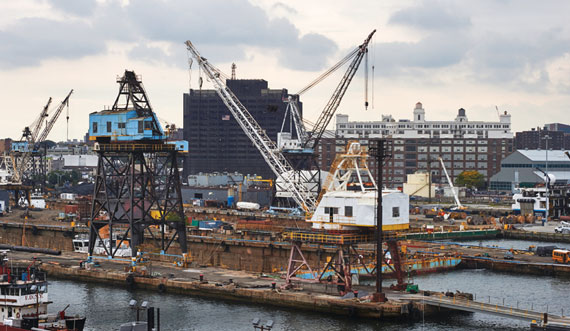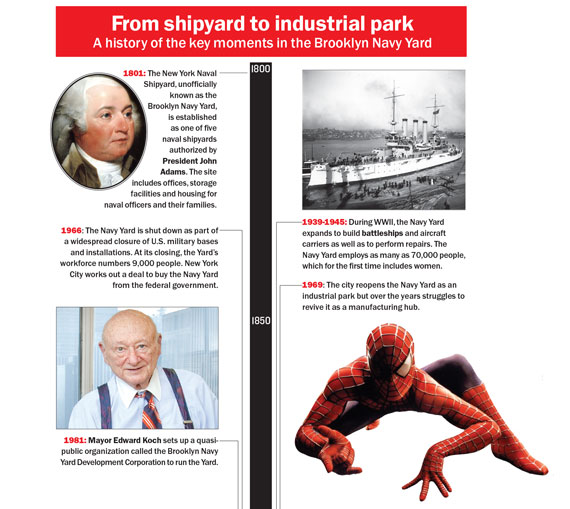At 300 acres, the Brooklyn Navy Yard is big enough to get lost in. So it helps to find a good lookout spot — like the rooftop farm atop a 12-story industrial building. It’s from here that one can see the pieces of a redevelopment in the making: an empty lot that will soon give rise to a new office building to be occupied by the shared office space provider WeWork, a decaying group of 19th-century row houses that will make way for a Wegmans supermarket and a hulking World War II-era warehouse called Building 77, where workers are currently removing tons of concrete to cut out windows and create rentable manufacturing space.
It’s a busy landscape. But standing recently between a row of herbs and vegetables, Brooklyn Navy Yard Development Corporation’s CEO David Ehrenberg pointed to a dry dock in the distance. There, he said, unskilled workers serve as fire watchers whose main duty is to keep an eye on unruly sparks that sometimes shoot from ships under repair. Many members of that lookout crew will graduate to high-paying welding jobs at the Navy Yard, opening a path to the middle class that has become increasingly out of reach for ordinary workers.
“This kind of training is hard to find in today’s economy,” Ehrenberg said.
Since taking over as manager of the Navy Yard in 2013, Ehrenberg has been charged with carrying out an ambitious and much lauded project for the city — providing a haven for manufacturing companies while redeveloping a historic-but-underutilized waterfront facility for the 21st century. With $1 billion in investment, $250 million of which is public money, the Navy Yard has over the last decade been transformed from a post-industrial wasteland into a thriving industrial park. Once current and future projects are completed, the Navy Yard will include 150,000 square feet of retail and 675,000 square feet of office space.
 Begun by his predecessor, Andrew Kimball, who left to spearhead a similar transformation at Industry City, the privately owned industrial park in Sunset Park, the plan to transform the Navy Yard was spurred by a desire to bring back manufacturing under a new model. That model is rooted in two groups working side-by-side: well-paid blue-collar manufacturers and high-tech creative companies.
Begun by his predecessor, Andrew Kimball, who left to spearhead a similar transformation at Industry City, the privately owned industrial park in Sunset Park, the plan to transform the Navy Yard was spurred by a desire to bring back manufacturing under a new model. That model is rooted in two groups working side-by-side: well-paid blue-collar manufacturers and high-tech creative companies.
It is founded on the belief that technology and physical product creation will increasingly merge and give way to innovation. “If you look around the kitchen, most of the appliances are ones your grandparents probably had,” Ehrenberg said. “The brightest minds in the technology world have said that this is going to change dramatically over the next 10 years and New York is going to be the center of it.”
Going ‘public’
At 39, Ehrenberg is in many ways picking up where Kimball left off. Like his predecessor, he is steeped in public service. A South Slope native who graduated from Wesleyan University, he began his career at Brooklyn Legal Services, where he coordinated a micro-lending program for local businesses. He went on to earn a master’s degree in public policy and urban planning from Princeton University.
After Princeton, he spent seven years at the New York City Economic Development Corporation. In 2011, he was named co-head of the agency’s real estate transaction group and worked on major projects such as Atlantic Yards and the redevelopment of Roosevelt Island.
“David is as smart as they come,” said Seth Pinsky, executive vice president at RXR Realty, who worked closely with Ehrenberg as NYCEDC’s president from 2008 to 2013. “He is very straight in the way that he thinks and an aggressive advocate for the city, but he also knows how to get deals done.”
On Ehrenberg’s watch, 18 new leases have been signed — two in 2013, six in 2014 and 10 in 2015. He renews about eight existing leases per quarter on average, he said.
Among the tenants, printing company Duggal Visual Solutions underwent a major expansion at the Navy Yard, creating a 100,000-square-foot production headquarters, while Brooklyn Roasting Company leased space for a new roasting and distribution center.
But arguably, Ehrenberg’s biggest achievement to date has been in helping to close the Wegmans deal. In May, the grocery-store chain was approved as a retail tenant for Admiral’s Row, a strip of Civil War-era homes that will be demolished to make way for 285,000 square feet of retail and office space. Steiner NYC, which created a 25-acre film studio at the Navy Yard, is developing the project under a ground-lease agreement. Construction is expected to kick off next year and will take between two to three years, according to Ehrenberg.
The 74,000-square-foot Wegmans store will be the first for the company in New York City. A family-owned chain based in Rochester, Wegmans has something of a cult following. It was described by the New York Times as striking “a balance between the variety of a Whole Foods, the prices of a Trader Joe’s and the scale of a Walmart.”
Given the buzz, Wegmans represents a potentially transformative opportunity for the Navy Yard. At the moment there is little reason for nearby residents to venture inside the fenced-in industrial site.
“Finalizing the deal with Wegmans and bringing in a big supermarket amenity is only going to help bring the community into the Navy Yard,” said Dan Marks, a vice president at Brooklyn-centric commercial brokerage TerraCRG.

A bird’s-eye view of the 300-acre industrial park
The supermarket will also undoubtedly be welcomed by the Navy Yard’s rapidly growing workforce. According to Ehrenberg, 7,000 people currently work in the Navy Yard — up from 3,500 a decade ago. Within the next five years, he expects that number to rise to 15,000, thanks in part to two developments — a $140 million plan to renovate a 17-story, 1-million-square-foot warehouse known as Building 77 into manufacturing space along with a $410 million plan by Rudin Management and Boston Properties to develop a 16-story, 675,000-square-foot office building on a site called Dock 72. Asking rents at Building 77 have been reported as ranging from around $20 per square foot for lower floors to $40 per square foot for the penthouse, while the developers of Dock 72 are seeking rents from from the low-$60 to mid-$70 range per square foot.
In the long term, the Navy Yard has a massive 15 million-plus square feet of unused development rights.
Competing interests?
But the effort to marry traditional manufacturing with the new creative economy has not been without controversy. In 2010, when the Navy Yard decided it would not renew the lease of modular company Capsys, it stirred worries that traditional industrial companies could be pushed out at the expense of media, entertainment and design firms. Capsys will close for good in March, after failing to find a location it could afford. And when it was announced this spring that Rudin and Boston Properties had selected WeWork as its anchor tenant at Dock 72, some critics bemoaned that industrial firms were being pushed aside.
To some, it all boiled down to rents. “The numbers rule,” said a manufacturing tenant based at the Yard, who spoke on the condition of anonymity. “If you can get more rent from a tech company with office space than a company that’s making widgets, who’s going to get the space?”
Ehrenberg disputed the claim that there is any tension between industrial and tech tenants, arguing that the tech and design companies expected to take space at Dock 72 are as important as manufacturing is for the Navy Yard’s success.
The way Ehrenberg sees it, the two sectors complement one another. And he pointed out that, unlike private landlords, the Navy Yard is a not-for-profit corporation, meaning it doesn’t need to achieve top-dollar rents.
Yet he acknowledged that there is a balance to be struck between housing manufacturing companies, which often need cheap rent, and raising revenue to pay for investments. However, he contended that such considerations have not kept the Navy Yard from keeping its traditional tenant base.
“To my knowledge we had one tenant in two years [who left], and he was going to close the business anyway,” he said.
The transit challenge
Unlike Downtown Brooklyn or Dumbo, the Navy Yard — which sits between South Williamsburg, Clinton Hill and Downtown Brooklyn — has no nearby subway stations. The nearest subway is the F train’s York Street station, which is a 10-minute walk.
The Brooklyn Navy Yard Development Corporation currently operates shuttle buses to subway stations. It will expand the service once Dock 72 opens.
According to Ehrenberg, Rudin Management and Boston Properties will match the BNYDC’s spending on additional transportation as part of their ground lease agreement.
One could also argue that its level of remoteness depends on where you live. It may take longer to get to the site from Manhattan, but for many Brooklyn residents, the Navy Yard is a mere CitiBike ride away. (The bike-share system has stations nearby.)
The developers are also betting that the views of the Manhattan skyline along with the real estate tax exemptions that the firm can tout to prospective tenants — a result of the fact that it’s on city-owned land — will more than make up for the lack of transportation. “As we look at negative factors or risk, we realize that, sure, transportation is challenging, but we think there’s ways to work through it,” said Michael Rudin, Rudin Management’s vice president. “There are no other negatives to [the Dock 72] site or the building.”
Without a doubt, the timing of the latest expansion push couldn’t be better. Between Dumbo’s numerous office projects and Two Trees’ Domino Sugar development, the Navy Yard will soon be wedged between two growing mixed-use districts.
As TerraCRG’s Ofer Cohen explained, the Navy Yard is benefitting from Downtown Brooklyn’s construction boom.
“When Downtown Brooklyn was rezoned, the initial vision was a new Midtown,” he said. But recently, commercial space has increasingly been converted into new apartment towers. This, he explained, is good news for the Navy Yard because it means office and manufacturing tenants looking to lease in Brooklyn have fewer options, much less one as large and uniquely located as the Navy Yard.
“There are very few waterfront properties left in Brooklyn,” Rudin said. “And none of them have a great deal of developable area.”
However, it remains to be seen whether the growing relationship between manufacturing and tech will be as central to the city’s economic future as Ehrenberg says. But many have come to believe the fate of manufacturing will rest on it.
“We’ve got to create an environment that’s true to our mission,” Ehrenberg said. “But also where those innovations and collaborations can just happen.”
